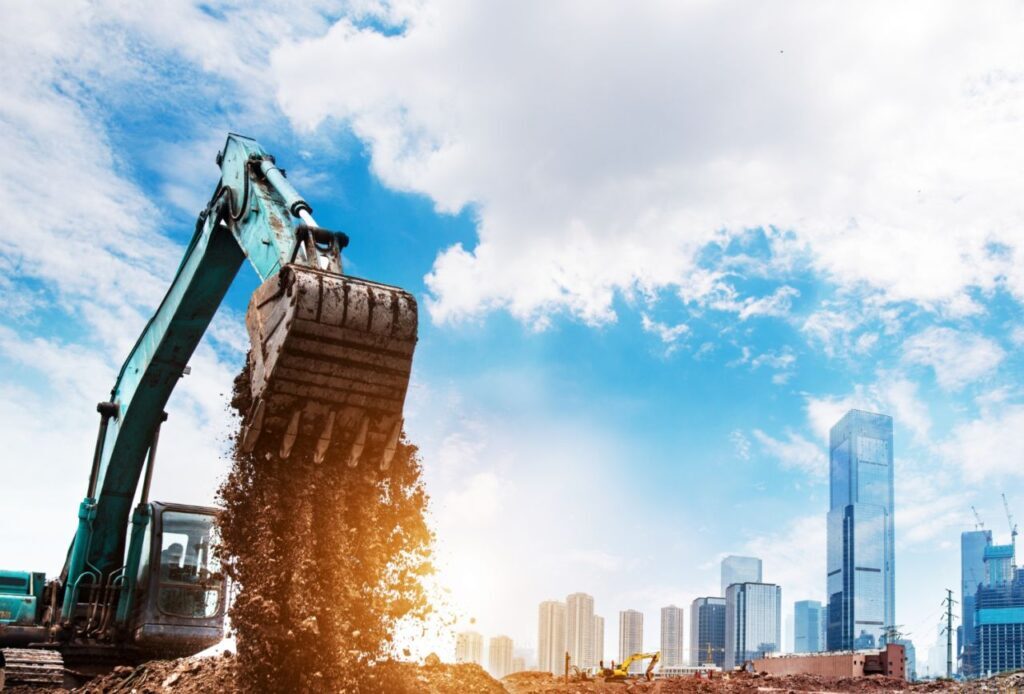Emerging Construction Technology Trends in 2024: A Comprehensive Outlook
The construction industry, one of the largest sectors globally, is undergoing a significant transformation.
As we approach 2024, the sector is poised to embrace new technologies and methodologies that promise to revolutionize traditional practices. This article delves into the top construction technology trends that are shaping the future of the industry.
 The drive towards sustainable construction is more than a trend; it’s a necessary shift in response to global environmental challenges. In 2024, this movement is characterized by the adoption of eco-friendly materials, energy-efficient designs, and innovative construction methods. Zero Net Energy Buildings (NZEBs) are at the forefront of this shift. These structures, designed to produce as much energy as they consume over a year, are becoming increasingly popular, driven by both consumer demand and regulatory requirements.
Sustainable building practices extend beyond energy efficiency. They encompass the use of non-toxic, recycled, and locally sourced materials, reduction in water usage, and minimization of construction waste.
Advanced materials like cross-laminated timber (CLT) are gaining prominence for their environmental benefits, offering a sustainable alternative to traditional construction materials like concrete and steel. These materials not only reduce the carbon footprint of construction projects but also enhance the buildings’ overall environmental performance.In the realm of design and planning, architects and builders are incorporating green principles from the outset.
This approach ensures that sustainability is not an afterthought but a fundamental component of the construction process. Whether it’s through the use of solar panels, green roofs, or energy-efficient windows, the industry is increasingly adopting practices that contribute to a more sustainable future.
The drive towards sustainable construction is more than a trend; it’s a necessary shift in response to global environmental challenges. In 2024, this movement is characterized by the adoption of eco-friendly materials, energy-efficient designs, and innovative construction methods. Zero Net Energy Buildings (NZEBs) are at the forefront of this shift. These structures, designed to produce as much energy as they consume over a year, are becoming increasingly popular, driven by both consumer demand and regulatory requirements.
Sustainable building practices extend beyond energy efficiency. They encompass the use of non-toxic, recycled, and locally sourced materials, reduction in water usage, and minimization of construction waste.
Advanced materials like cross-laminated timber (CLT) are gaining prominence for their environmental benefits, offering a sustainable alternative to traditional construction materials like concrete and steel. These materials not only reduce the carbon footprint of construction projects but also enhance the buildings’ overall environmental performance.In the realm of design and planning, architects and builders are incorporating green principles from the outset.
This approach ensures that sustainability is not an afterthought but a fundamental component of the construction process. Whether it’s through the use of solar panels, green roofs, or energy-efficient windows, the industry is increasingly adopting practices that contribute to a more sustainable future.
Digital Transformation in Construction
1. Digital Information Management (DIM)
The evolution from BIM to DIM marks a significant shift in the industry’s approach to managing construction data. DIM not only simplifies the concept of BIM but also broadens its scope, making it more accessible and integral to all stakeholders involved in a construction project. This transition is about moving from the mere digital representation of physical and functional characteristics of a building to a more holistic management of digital information. It opens doors to enhanced collaboration, improved accuracy in planning and data analytics, and a streamlined approach to project management. As DIM becomes more prevalent, it will likely revolutionize how information is shared and utilized across the construction lifecycle, from initial design to final construction.2. Digital Twin Technology
Digital Twin technology is set to be a transformative force in the construction industry. By creating a dynamic virtual model of a construction project that updates in real-time, it offers unparalleled insights into the construction process. This technology goes beyond traditional modeling, allowing for the simulation of scenarios and the visualization of their real-world outcomes. Its unique capability to spotlight the interplay between people, processes, and built environments offers a new dimension to construction management. The predictive analytics and scenario modeling made possible by Digital Twin technology are instrumental in minimizing risks, enhancing efficiency, and reducing costs. As this technology matures, its integration with BIM will likely become more seamless, offering a more comprehensive view of construction projects.3. Connected Construction Sites
The concept of connected construction sites represents a major leap in on-site coordination and efficiency. By harnessing the power of wireless and digital technologies, these connected ecosystems enable real-time communication and collaboration among various project stakeholders. This network of people, equipment, vehicles, and devices ensures that information is shared instantaneously, leading to improved decision-making and resource management. The benefits extend to safety enhancements, with instant communication enabling quicker responses to on-site incidents. Additionally, the integration of IoT devices and sensors on these sites facilitates the capture of crucial data, further refining construction processes and outcomes. As this trend gains momentum, the construction site of the future will likely be a hub of digital interaction, optimizing operations and elevating the standards of project execution.Technological Innovations
4. Advanced Robotics and Automation
The integration of robotics and automation in construction heralds a new era marked by increased efficiency and safety. Robots, equipped with AI and machine learning capabilities, are now taking on complex tasks such as brick-laying, welding, and even intricate assembly work. These mechanical marvels are not just about replacing human labor; they are transforming it. By handling repetitive, labor-intensive tasks, they free up human workers to focus on more skilled and strategic aspects of construction. The potential of robotics extends beyond mere labor substitution. They bring precision and consistency, significantly reducing the margin for error and enhancing the overall quality of construction. Moreover, their application in hazardous environments minimizes risk to human workers, thereby improving on-site safety. However, the adoption of robotics is not without its challenges. Navigating complex environments and adapting to diverse weather conditions remain areas for further development. Despite these challenges, the trajectory of construction robotics points toward more sophisticated, versatile, and adaptable machines, poised to become standard equipment on construction sites.5. Drone Technology
Drones, or Unmanned Aerial Vehicles (UAVs), have rapidly become indispensable in the construction industry. Their ability to capture aerial imagery and data offers a new perspective on construction site management. From site surveying and mapping to monitoring project progress and conducting safety inspections, drones provide invaluable insights that were previously difficult or impossible to obtain. The real-time data gathered by drones is a game-changer, allowing for immediate responses to site conditions and potential issues. This capability is crucial in ensuring project timelines are met and in identifying and mitigating risks before they escalate. Furthermore, the integration of drones with other technologies, such as VR and AI, is enhancing their functionality. This synergy enables more accurate and comprehensive project analysis, facilitating better planning and decision-making.6. 3D Printing and Additive Manufacturing
3D printing in construction, also known as additive manufacturing, is reshaping the industry’s approach to building. By enabling the creation of complex structures from digital designs, this technology reduces construction time, labor costs, and material waste. It represents a shift towards more sustainable and efficient building practices. The scope of 3D printing extends beyond small components to entire structures, including houses, bridges, and potentially skyscrapers. This technology not only streamlines the construction process but also opens up new possibilities for design innovation, allowing for the creation of unique, customized structures that were once considered impractical or too costly with traditional building methods.7. Artificial Intelligence (AI)
AI in construction is emerging as a transformative force. Its applications range from predictive analytics and project management to generative design and knowledge capture. AI algorithms can analyze vast amounts of data from various sources, providing insights that enable better planning, risk management, and decision-making. One of the most promising applications of AI is in capturing the tacit knowledge of experienced workers. As the industry faces a brain drain due to an aging workforce, AI offers a way to preserve this invaluable expertise. By leveraging large language models and other AI tools, the industry can create knowledge bases that encapsulate decades of experience, ensuring this wisdom is not lost but rather passed on to the next generation of construction professionals.Sustainable and Safe Construction
8. Green Building and Sustainability
 The drive towards sustainable construction is more than a trend; it’s a necessary shift in response to global environmental challenges. In 2024, this movement is characterized by the adoption of eco-friendly materials, energy-efficient designs, and innovative construction methods. Zero Net Energy Buildings (NZEBs) are at the forefront of this shift. These structures, designed to produce as much energy as they consume over a year, are becoming increasingly popular, driven by both consumer demand and regulatory requirements.
Sustainable building practices extend beyond energy efficiency. They encompass the use of non-toxic, recycled, and locally sourced materials, reduction in water usage, and minimization of construction waste.
Advanced materials like cross-laminated timber (CLT) are gaining prominence for their environmental benefits, offering a sustainable alternative to traditional construction materials like concrete and steel. These materials not only reduce the carbon footprint of construction projects but also enhance the buildings’ overall environmental performance.In the realm of design and planning, architects and builders are incorporating green principles from the outset.
This approach ensures that sustainability is not an afterthought but a fundamental component of the construction process. Whether it’s through the use of solar panels, green roofs, or energy-efficient windows, the industry is increasingly adopting practices that contribute to a more sustainable future.
The drive towards sustainable construction is more than a trend; it’s a necessary shift in response to global environmental challenges. In 2024, this movement is characterized by the adoption of eco-friendly materials, energy-efficient designs, and innovative construction methods. Zero Net Energy Buildings (NZEBs) are at the forefront of this shift. These structures, designed to produce as much energy as they consume over a year, are becoming increasingly popular, driven by both consumer demand and regulatory requirements.
Sustainable building practices extend beyond energy efficiency. They encompass the use of non-toxic, recycled, and locally sourced materials, reduction in water usage, and minimization of construction waste.
Advanced materials like cross-laminated timber (CLT) are gaining prominence for their environmental benefits, offering a sustainable alternative to traditional construction materials like concrete and steel. These materials not only reduce the carbon footprint of construction projects but also enhance the buildings’ overall environmental performance.In the realm of design and planning, architects and builders are incorporating green principles from the outset.
This approach ensures that sustainability is not an afterthought but a fundamental component of the construction process. Whether it’s through the use of solar panels, green roofs, or energy-efficient windows, the industry is increasingly adopting practices that contribute to a more sustainable future.


Leave a Reply